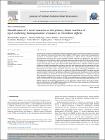| dc.contributor.author | MAC AOG?IN, MICHE?L | en |
| dc.contributor.author | MOLONEY, GERALDINE | en |
| dc.contributor.author | ROGERS, THOMAS | en |
| dc.date.accessioned | 2015-12-01T16:29:58Z | |
| dc.date.available | 2015-12-01T16:29:58Z | |
| dc.date.issued | 2015 | en |
| dc.date.submitted | 2015 | en |
| dc.identifier.citation | Miche?l Mac Aog?in. Shauna Kilkenny, Claire Walsh, Sin?ad Lindsay, Geraldine Moloney, Trefor Morris, Sophie Jones, Thomas R. Rogers, Identification of a novel mutation at the primary dimer interface of GyrA conferring fluoroquinolone resistance in Clostridium difficile, Journal of Global Antimicrobial Resistance, 2015 | en |
| dc.identifier.other | Y | en |
| dc.identifier.uri | http://hdl.handle.net/2262/74976 | |
| dc.description | IN_PRESS | en |
| dc.description.abstract | The
aim
of
this
study
was
to
determine
whether
alternative
resistance
mechanisms,
other
than
mutation
in
the
quinolone
resistance-determining
region
(QRDR)
of
DNA
gyrase,
could
confer
fluoroquinolone
resistance
in
Clostridium
difficile
.
An
in
vitro-generated
C.
difficile
mutant
exhibiting
increased
fluoroquinolone
resistance
was
isolated
through
antibiotic
selection
on
ciprofloxacin.
The
QRDR
of
this
mutant
was
investigated
by
chain-termination
sequencing
and
was
found
to
be
devoid
of
mutation.
To
determine
the
nature
of
the
non-QRDR
resistance
mechanism
in
this
strain,
the
genomes
of
the
mutant
and
wild-type
strains
were
sequenced.
The
gyrBA
region
from
a
collection
of
clinical
isolates
exhibiting
variable
fluoroquinolone
resistance
levels
was
also
sequenced
and
was
compared
with
that
present
in
918
publicly
available
C.
difficile
genomic
data
sets.
Whole-genome
sequence
analysis
of
the
fluoroquinolone-resistant
mutant
revealed
a
single
non-synonymous
substitution
(Ala384Asp)
at
the
predicted
primary
dimer
interface
of
GyrA,
far
beyond
the
classically
defined
QRDR.
This
novel
mutation
caused
increased
resistance
to
ciprofloxacin,
ofloxacin,
levofloxacin
and
moxifloxacin
while
conferring
hypersusceptibility
to
novobiocin.
Several
novel
extra-QRDR
polymorphisms
in
C.
difficile
DNA
gyrase
were
identified
among
clinical
isolates,
whilst
observed
fluoroquinolone
resistance
in
strains
devoid
of
gyrBA
mutations
confirmed
the
existence
of
DNA
gyrase-independent
resistance
mechanisms
in
this
species.
In
conclusion,
we
report
the
first
non-QRDR
mutation
to
confer
fluoroquinolone
resistance
in
C.
difficile.
Although
the
Ala384Asp
substitution
was
not
detected
in
clinical
isolates,
this
study
revealed
a
diversity
of
alternative
extra-QRDR
polymorphisms
in
DNA
gyrase
whose
association
with
fluoroquin-
olone
resistance
warrants
further
investigation. | en |
| dc.language.iso | en | en |
| dc.relation.ispartofseries | Journal of Global Antimicrobial Resistance | en |
| dc.rights | Y | en |
| dc.title | Identification of a novel mutation at the primary dimer interface of GyrA conferring fluoroquinolone resistance in Clostridium difficile | en |
| dc.type | Journal Article | en |
| dc.type.supercollection | scholarly_publications | en |
| dc.type.supercollection | refereed_publications | en |
| dc.identifier.peoplefinderurl | http://people.tcd.ie/macaogam | en |
| dc.identifier.peoplefinderurl | http://people.tcd.ie/rogerstr | en |
| dc.identifier.peoplefinderurl | http://people.tcd.ie/moloneg2 | en |
| dc.identifier.rssinternalid | 107838 | en |
| dc.rights.ecaccessrights | openAccess | |
| dc.subject.TCDTheme | Immunology, Inflammation & Infection | en |
| dc.subject.TCDTag | ANTIBIOTIC RESISTANCE | en |
| dc.subject.TCDTag | Antibiotic resistance mechanisms | en |
| dc.subject.TCDTag | CLOSTRIDIUM DIFFICILE | en |
| dc.subject.TCDTag | Microbial genomics | en |
| dc.subject.TCDTag | Pathogen genomics | en |
| dc.identifier.rssuri | http://www.jgaronline.com/article/S2213-7165%2815%2900099-5/pdf | en |
| dc.identifier.rssuri | https://www.ncbi.nlm.nih.gov/pubmed/?term=27842877 | en |
| dc.identifier.orcid_id | 0000-0002-1726-7700 | en |
| dc.status.accessible | N | en |




